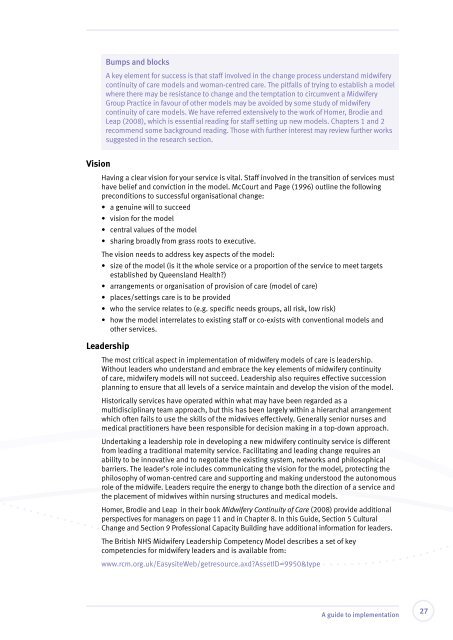Delivering continuity of midwifery care to Queensland women
Delivering continuity of midwifery care to Queensland women
Delivering continuity of midwifery care to Queensland women
You also want an ePaper? Increase the reach of your titles
YUMPU automatically turns print PDFs into web optimized ePapers that Google loves.
Bumps and blocks<br />
A key element for success is that staff involved in the change process understand <strong>midwifery</strong><br />
<strong>continuity</strong> <strong>of</strong> <strong>care</strong> models and woman-centred <strong>care</strong>. The pitfalls <strong>of</strong> trying <strong>to</strong> establish a model<br />
where there may be resistance <strong>to</strong> change and the temptation <strong>to</strong> circumvent a Midwifery<br />
Group Practice in favour <strong>of</strong> other models may be avoided by some study <strong>of</strong> <strong>midwifery</strong><br />
<strong>continuity</strong> <strong>of</strong> <strong>care</strong> models. We have referred extensively <strong>to</strong> the work <strong>of</strong> Homer, Brodie and<br />
Leap (2008), which is essential reading for staff setting up new models. Chapters 1 and 2<br />
recommend some background reading. Those with further interest may review further works<br />
suggested in the research section.<br />
Vision<br />
Having a clear vision for your service is vital. Staff involved in the transition <strong>of</strong> services must<br />
have belief and conviction in the model. McCourt and Page (1996) outline the following<br />
preconditions <strong>to</strong> successful organisational change:<br />
• a genuine will <strong>to</strong> succeed<br />
• vision for the model<br />
• central values <strong>of</strong> the model<br />
• sharing broadly from grass roots <strong>to</strong> executive.<br />
The vision needs <strong>to</strong> address key aspects <strong>of</strong> the model:<br />
• size <strong>of</strong> the model (is it the whole service or a proportion <strong>of</strong> the service <strong>to</strong> meet targets<br />
established by <strong>Queensland</strong> Health)<br />
• arrangements or organisation <strong>of</strong> provision <strong>of</strong> <strong>care</strong> (model <strong>of</strong> <strong>care</strong>)<br />
• places/settings <strong>care</strong> is <strong>to</strong> be provided<br />
• who the service relates <strong>to</strong> (e.g. specific needs groups, all risk, low risk)<br />
• how the model interrelates <strong>to</strong> existing staff or co-exists with conventional models and<br />
other services.<br />
Leadership<br />
The most critical aspect in implementation <strong>of</strong> <strong>midwifery</strong> models <strong>of</strong> <strong>care</strong> is leadership.<br />
Without leaders who understand and embrace the key elements <strong>of</strong> <strong>midwifery</strong> <strong>continuity</strong><br />
<strong>of</strong> <strong>care</strong>, <strong>midwifery</strong> models will not succeed. Leadership also requires effective succession<br />
planning <strong>to</strong> ensure that all levels <strong>of</strong> a service maintain and develop the vision <strong>of</strong> the model.<br />
His<strong>to</strong>rically services have operated within what may have been regarded as a<br />
multidisciplinary team approach, but this has been largely within a hierarchal arrangement<br />
which <strong>of</strong>ten fails <strong>to</strong> use the skills <strong>of</strong> the midwives effectively. Generally senior nurses and<br />
medical practitioners have been responsible for decision making in a <strong>to</strong>p-down approach.<br />
Undertaking a leadership role in developing a new <strong>midwifery</strong> <strong>continuity</strong> service is different<br />
from leading a traditional maternity service. Facilitating and leading change requires an<br />
ability <strong>to</strong> be innovative and <strong>to</strong> negotiate the existing system, networks and philosophical<br />
barriers. The leader’s role includes communicating the vision for the model, protecting the<br />
philosophy <strong>of</strong> woman-centred <strong>care</strong> and supporting and making unders<strong>to</strong>od the au<strong>to</strong>nomous<br />
role <strong>of</strong> the midwife. Leaders require the energy <strong>to</strong> change both the direction <strong>of</strong> a service and<br />
the placement <strong>of</strong> midwives within nursing structures and medical models.<br />
Homer, Brodie and Leap in their book Midwifery Continuity <strong>of</strong> Care (2008) provide additional<br />
perspectives for managers on page 11 and in Chapter 8. In this Guide, Section 5 Cultural<br />
Change and Section 9 Pr<strong>of</strong>essional Capacity Building have additional information for leaders.<br />
The British NHS Midwifery Leadership Competency Model describes a set <strong>of</strong> key<br />
competencies for <strong>midwifery</strong> leaders and is available from:<br />
www.rcm.org.uk/EasysiteWeb/getresource.axdAssetID=9950&type<br />
A guide <strong>to</strong> implementation<br />
27
















